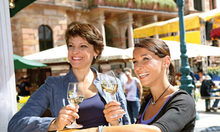History

The history of the "Wiesbaden Wine Festival" in the Hessian capital was a success story from the very beginning. It was founded in 1976 with the aim of improving the urbanity of the city and providing the Rheingau vintners a platform on which to offer their wonderful produce. At the premiere, still and sparkling wines were presented at 33 stands spread around the Schlossplatz, Mauritiusplatz and the pedestrian zone. The wine festival was such an immediate hit that the number of stands rose to 60 in the following year, and in 1978, when the festival area was extended to include more of the pedestrian zone, the wine festival boasted some 80 stands.
It didn’t take long to break the "100 mark". Since the early 1980s when the produce on offer at the Rheingau Wine Festival was successively expanded to include culinary delicacies, the number of stands has reached a stable 115. Their lining the Wiesbaden pedestrian zone resulted in the Wine Festival being lovingly named the "longest wine bar in the world". Structural modifications in the pedestrian zone resulted in the relocation of some of the stands to Schützenhofstrasse, among other places, also known and loved by wine fans as the "Schlutzergässche". In subsequent years, Luisenplatz was also integrated in the festival but given up for the Dern’sches Gelände towards the end of the 1990s.
The combination of wine and music is unbeatable, and thus more and more musical interludes were organized at the Rheingau Wine Festival. In 2001, a year after the 25th anniversary of the Rheingau Wine Festival was hugely celebrated with special attractions; the music concept was revised with the aim of giving up-and-coming bands a chance. Since then, emphasis has also been on more modern music styles to accommodate the taste of the younger visitors.
2002 marked the "end" of the classic wine rummer which had served as the symbol of the Rheingau Wine Festival for many years. Today, a Rheingau wine glass symbolizes the premium event that attracts thousands of visitors to the Hessian capital every year.
At the request of the vintners, the Rheingau Wine Festival was given a new looking in 2003, which it still has today: the stands are located at the Schlossplatz, the square in front of the Wiesbadener Marktkirche (market church) and the Dern’sches Gelände. The "scattering" of the wine festival through the pedestrian zone was finally a thing of the past. Since then, there is music on three stages at the Schlossplatz in front of the Wiesbaden Rathaus (city hall), on the stage in front of the Marktkirche and the stage at the Dern’sches Gelände.
The Wine Festival always has specials in store and yet remains true to its character as a jovial and attractive event. Extended to ten days in 1995, the vintners avail of the opportunity to treat their regulars and win new customers. Visitors to the nationwide renowned Rheingau Wine Festival include large numbers of regulars, some of whom travel from afar. Still wine and sparkling wine consumption at every Rheingau Wine Festival is estimated at 300,000 bottles.

